|
|
|
|||
|
|
||||
|
|
||||
| The Smoky Addiction | ||||
|
|
HOME | SITE MAP | FORUM | CONTACT |
|
||
|
ABOUT | MOTORS | MODELS | ARCHIVE | HISTORY | STORE | FAQ | LINKS
|
|
|
|
|
|
|||||||||||||||||||||||||||||||||||||||||||||||||||||||||
|
The Smoky Addiction 8
(August 2005)
by Roger Simmonds Reprinted from SAM 35 Speaks, August 2005 Having moved to a new house, there is the possibility of actually building again, and an end to purely vicarious modelling. There will be much else to do, and this column will inevitably be somewhat curtailed. A jolly good thing too, I hear you say: more room in SAM Speaks for proper model aircraft! |
|
|||||||||||||||||||||||||||||||||||||||||||||||||||||||||
|
In our enthusiasm for Jetex type propulsion it is all too easy to forget that Rapier motors are the brainchild of Jan Zigmund of the Czech Republic, and are not, as was Jetex, a British invention. Rapiers are thus readily available on the Continent, and Adam Jenik, whose Douglas Skyrocket appeared in March’s Smoky Addiction, organised a meeting in Prague recently. Our intrepid foreign correspondent, Terry Kidd, went along. He reports: “I received an e-mail from Adam inviting me to Kbely for the Rapier ‘Fly-in’ on Saturday the 18th of June. Now Kbely has a superb air museum with all manner of unusual types, including Soviet-era jets of the kind we like so well. Not only that, but we could fly our Rapier models and a certain Dr Z would be there with a huge selection of Rapiers. “I found Prague, but missed my turn-off to Kbely and had to backtrack, stopping at filling stations to ask directions. At length, and after exchanging a few words with Adam via a mobile phone, buildings with all the hallmarks of a military airbase came into view. And there was Adam. After a quick trip around the museum (I’ll be back for another look soon), I met Dr Z with his huge stock of motors. Rapiers, hundreds of ‘em! He also had a couple of prototype electrical igniters, which worked very well. There were some lovely models around and plenty of good stuff to watch. Adam’s models all flew very well, though unfortunately his Flitzer got lost – but that is what [all good] Flitzers do. After about an hour, and watching a Lightning flown by one of Adam’s friends performing superbly, I was struck by the wonder of it all [&133;] I worked on Lightnings back in 1970 when I was an 'erk [&133;] and here I was on an airfield outside Prague watching a Rapier/Jetex Lightning flying around on the longest day of the year, with a [full size] MiG 21 behind me and Dr Z with a Skoda full of rocket motors. WOW!”
|

- Adam Jenik, June 2005
 Line-up at the Prague Rapier summit Left, top to bottom: Cutlass, MIG-21, Sabre (Vladimir Matiskovic), Saab J-29 (Stanislov Cerny), Miles M.52 (Adam Jenik), MIG-15 (Terry Kidd), rocket glider (Dennis) Right, top to bottom: Slinky, Comet, Loon, D-558-2, Flitzer (Adam Jenik), Lightning (Viktor Lukac), X-1 (Gregor Weingarten)
- Adam Jenik, June 2005
|
|||||||||||||||||||||||||||||||||||||||||||||||||||||||||
|
|
|
|||
|
Meanwhile, back in the land of Jetex, Steve Bage and Mike Stuart are making excellent progress with their new models. Steve has finished his Hawker P.1121 fighter/bomber [right]. Despite the recent inclement weather, and some concerns about the model’s lack of dihedral, a number of successful test flights have been completed. Steve writes: “The P.1121 proved a bit tail heavy and I needed a few flights and a lump of ‘Blu-Tack’ [ugh!] on the nose to get the balance right. Eventually I got a decent flight with a 130 mN motor, the power phase showing a nice climb with a gentle right turn, but the glide was quite steep and when it landed the Blu-Tack fell off and got lost in the long grass. As without this the model performs a quite spectacular series of tight loops (it just about got me in the back of the head with the first loop – very entertaining if not very scale-like), and as I didn’t have any more, that was the end of flying for the day.” Hmm, there must be a moral here! The sweepback appears to be sufficient to compensate for the zero dihedral, but there is obviously still some sorting out to do with the model. Steve removed some wood from the rear formers with a pencil wrapped in ‘wet and dry’, gaining access through the open rear nozzle. This will reduce the need for Blu-Tack, which is all to the good. However, other (now almost forgotten) approaches to trimming are possible. Steve says he may try trim tabs on the tailplane to effect ‘down elevator’ (note that the tail feathers are all-sheet and immovable), but a better approach would be the application of downthrust, which would allow the manipulation and optimisation of the power phase without affecting the glide. |
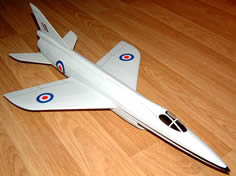
- Steve Bage
|
|||
|
Steve’s F-105 Thunderchief (see June’s article) is nearly finished. With a span of 10'', a length of 19.5'' and a weight of 26 g (covered but unpainted), this is an interesting design worth some discussion. Steve thought it might be something of a ‘lead sled’, too large and heavy to fly (just like the real thing), but the statistics are actually quite encouraging. The wing area is about 28 sq. in.; if the all-up weight is 30 g, (allowing 5 g for the final finish) then the wing loading will be about 5-6 oz/sq. ft, only a little higher than the Flitzer. Steve reports: “I've just been over the local field and given it a 'chuck around’. As expected the glide is quite fast but not excessively so, and quite flat. Trim was correct straight off the board, no nose or tail weight was required, and it appears to be stable in all axes. I’ll wait until I get it finished before I light the fuse. It did prove a bit awkward to launch, as it’s quite hard to get a decent grip of the fuselage under the wing, and I got better results by holding it just in front of the air intakes.” Several other people, including Mike Stuart and Ollie Holmes, are also building the Thud and report it goes together very well, so if you would like a copy of his plan please contact Steve. The Thud is an excellent example of a modern (though ‘retro’) design, and I particularly like the multiple stringers and the use of small amounts of sheeting in appropriate areas, for example around the air intakes and the cockpit. These small but important details make such a difference to the realism of a finished model. Building this large and complex structure down to 30 g is a considerable achievement, showing not only what can be done with careful selection of balsa, but also what we had to put up with (in terms of balsa quality) in the old days. You will remember that I had a slight concern about the narrowness of the trough with this model – I prefer ‘Jetex-size troughs’ on my models – but the modern trend is to make troughs as small as possible so that the contours of the fuselage are preserved. If this is taken too far the thrust from the Rapier will be reduced – perhaps Steve can incorporate active air intakes and a flow of air over the motor and through the trough in his next design. |
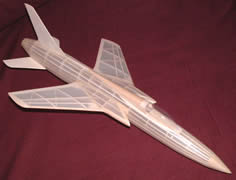
- Steve Bage
|
|||
|
The ever-diligent Mike Stuart is building a Skyleada YF-100 Super Sabre (see the (Jet)X Files, October 2004) as well as the F-105. This early 1950s design for the original Jetex 50 has many similarities to the Mystère IV by the same designer (whose identity is uncertain): it certainly provides a nice contrast to the F-105. Mike writes: “The span is the same as the Mystère IV, but the fuselage is longer and the wings are nearer the back. The design is minimalist compared to most modern designs, and surely there are not enough stringers, are there? There is plenty of wing area, so this could be a real floater. Despite the size, [it is 14" span, 17-18" long] I am confident it will go well with a low power L2 (100 mN or thereabouts). I changed a few things along the way, but kept the character of the original design intact (so I will not be adding any more stringers). I built the wings as per the original design apart from using soft block for the tips rather than “The wing root gussets have yet to be added. Dihedral shown on the plan is ½" per side, and I will see how I go with this. The trough is very generous for Rapier power, and could have been made much narrower, but I left it alone [good!]. I will be filling-in below the motor tube with a bit of soft sheet to hide it. The reinforcing gussets will be where the wing trailing edge meets the fuselage. This is a high stress area when the model is doing cartwheels. One thing I have done is to move the front former rearwards (and made it slightly bigger to compensate) so I can have a deeper hollow intake to hide nose weight”. [No unsightly lumps of Blu-Tack here!]. Note, too, that Mike has taken large scallops out of the fuselage formers so that they won’t show through the tissue covering. I myself would find it difficult to resist adding extra stringers, and I’m sure I would have reduced the dihedral. All in all, though, this is coming together very nicely. The Super Sabre is, says Chris Strachan, a peculiarly difficult prototype to ‘capture’, and I look forward to seeing this one in the air. I had a couple of fascinating letters from Bob Pickernell, whose exploits with the Jetex Flying Wing were reported last month. Bob also indulges in scale models, and writes: |
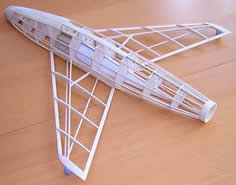
- Mike Stuart
|
|||
|
“Here is a picture of my current project [right]. It is another of the ‘what if?’ type of models that seem very popular at the moment. The full size prototype was the Vickers 559 of 1950s vintage. It would have been of mixed jet and rocket [two Spectre Juniors either side of the twin afterburner nozzles] with a Mach 2 plus performance and was designed as the Vicker’s entry for the T 55 contest. Interestingly, the Hawker entry was the P.1103 which had a fuselage and tail almost identical to the P.1121, but with a different wing. Steve Bage’s beautiful model does great credit to the elegant P.1121. I think you will agree the V.559 was more aggressive than elegant. It is 17"
long and 12" span, but the foreplane is larger than the photo suggests so the total projected area should be OK when you consider the F-104. As far as the cg goes, I used the equations in Martin Simmons’ Model Aircraft Aerodynamics then checked it out with an all-sheet chuck glider. Seemed about right, so I taped on an L2 for laughs. Somewhat overpowered, to say the least. Stability on the glide also seemed all right. There is considerable dihedral on the foreplane – Vickers called this a ‘Lobster Claw’ arrangement.” The V.559, was, like the other T 55 contenders, (and, incidentally, the contemporaneous F-103 and the slightly later MiG 25), designed to counter the (largely illusory) threat of hostile bombers coming in fast at 60-70,00 ft. The V.559 came third in the design competition, behind the P.1103 and the impressively large Fairey Delta III. These, too, would make interesting and unique subjects for modelling. Having discussed one old and two modern designs, I will finish with an amalgamation of one that is both old and new. D P Golding’s D.H. 108 Swallow for enclosed Jetex 100 (Aeromodeller, July 1952) is an iconic model that stimulated my own effort for Rapier L2 (see the (Jet)X Files, March 2003). Steve Bage has taken the pathetic scraps of my ‘plan’ and made many detail improvements, turning them into a real work of CAD art. Golding’s original plan was of course for the second prototype, whose bulky canopy and large air intakes I really liked, but Steve’s recreation also indicates the more streamlined outlines of the third prototype. It will be wonderful to see more examples of this real classic flying again, so if you would like a copy of the plan [in reduced format below] please contact Steve or me. |

- Bob Pickernell
|
|||
 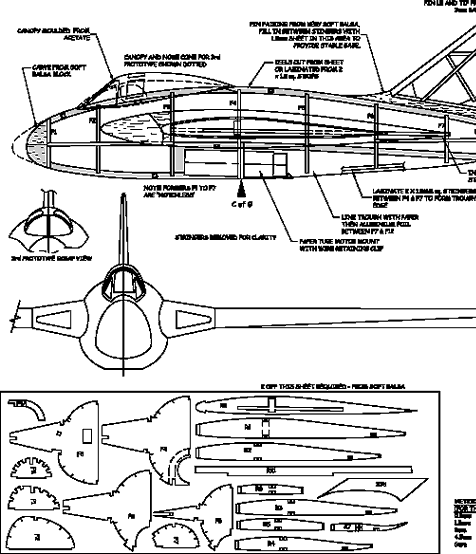
|
|
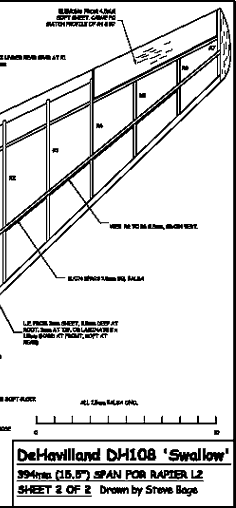 
|
||
|
|
||||
|
|
|
|||
|
|
|
|
|
|
|
|
Acknowledgements - Article: Roger Simmonds - Illustrations: Steve Bage, Adam Jenik, Bob Pickernell, Mike Stuart |
|
|
|
|
ABOUT | MOTORS | MODELS | ARCHIVE | HISTORY | STORE | FAQ | LINKS |
|
|
Terms of Use
|
Queries? Corrections? Additions?
Please
contact us.
|
|